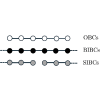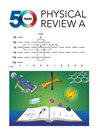Interplay of finite- and infinite-size stability in quadratic bosonic Lindbladians
IF 2.9
2区 物理与天体物理
Q2 Physics and Astronomy
引用次数: 0
Abstract
We provide a framework for understanding dynamical metastability in open many-body systems of free bosons, whereby the dynamical stability properties of the system in the infinite-size (thermodynamic) limit may sharply differ from those of any finite-size truncation, and anomalous transient dynamics may arise. By leveraging pseudospectral techniques, we trace the discrepancy between asymptotic and transient dynamics to the non-normality of the underlying quadratic bosonic Lindbladian (QBL) generator and show that two distinct flavors of dynamical metastability can arise. QBLs exhibiting type I dynamical metastability, previously discussed in the context of anomalous transient amplification [Phys. Rev. Lett. 127, 245701 (2021)], are dynamically unstable in the infinite-size limit yet stable once open boundaries are imposed. In contrast, type II dynamically metastable QBLs, which we uncover in this work, are dynamically stable for infinite size but become unstable under open boundary conditions for arbitrary finite system size. We exhibit representative models for both types of metastability in the dissipative, as well as the closed-system (Hamiltonian) settings, and analyze distinctive behavior they can engender. We show that dynamical metastability manifests itself in the generation of entanglement entropy by way of a transient which reflects the stability phase of the infinite (rather than the actual finite) system and, as a result, is directly tied to the emergence of supervolume entanglement scaling in type I systems. Finally, we demonstrate how, even in Hermitian, and especially in highly non-normal regimes, the spectral properties of an infinite-size QBL are reflected in the linear response functions of the corresponding finite QBLs by way of resonant pseudospectral modes.

二次玻色林德布拉德中有限和无限大小稳定性的相互作用
我们提供了一个框架来理解自由玻色子开放多体系统的动力学陨变,在这个框架中,系统在无限大小(热力学)极限的动力学稳定性特性可能与任何有限大小截断的动力学稳定性特性截然不同,并且可能出现反常的瞬态动力学。通过利用伪谱技术,我们将渐近动力学和瞬态动力学之间的差异追溯到底层二次玻色林德布拉德(QBL)发生器的非正态性,并证明可能出现两种不同的动力学陨变。QBLs 表现出的第一类动态隐变性,以前在反常瞬态放大的背景下讨论过[Phys. Rev. Lett. 127, 245701 (2021)],在无限大极限下动态不稳定,但一旦施加开放边界就会稳定。相反,我们在这项工作中发现的第二类动态瞬变 QBLs 在无限大时是动态稳定的,但在任意有限系统大小的开放边界条件下就变得不稳定了。我们展示了在耗散和封闭系统(哈密顿)环境中这两种类型的陨变性的代表模型,并分析了它们可能产生的独特行为。我们表明,动态陨变性表现为通过瞬态产生纠缠熵,这种瞬态反映了无限(而非实际有限)系统的稳定阶段,因此与 I 型系统中出现的超体积纠缠缩放直接相关。最后,我们证明了即使在赫米特,特别是在高度非正态分布情况下,无限大小 QBL 的频谱特性如何通过共振伪频谱模式反映在相应有限 QBL 的线性响应函数中。
本文章由计算机程序翻译,如有差异,请以英文原文为准。
求助全文
约1分钟内获得全文
求助全文
来源期刊

Physical Review A
物理-光学
CiteScore
5.40
自引率
24.10%
发文量
0
审稿时长
2.2 months
期刊介绍:
Physical Review A (PRA) publishes important developments in the rapidly evolving areas of atomic, molecular, and optical (AMO) physics, quantum information, and related fundamental concepts.
PRA covers atomic, molecular, and optical physics, foundations of quantum mechanics, and quantum information, including:
-Fundamental concepts
-Quantum information
-Atomic and molecular structure and dynamics; high-precision measurement
-Atomic and molecular collisions and interactions
-Atomic and molecular processes in external fields, including interactions with strong fields and short pulses
-Matter waves and collective properties of cold atoms and molecules
-Quantum optics, physics of lasers, nonlinear optics, and classical optics
 求助内容:
求助内容: 应助结果提醒方式:
应助结果提醒方式:


